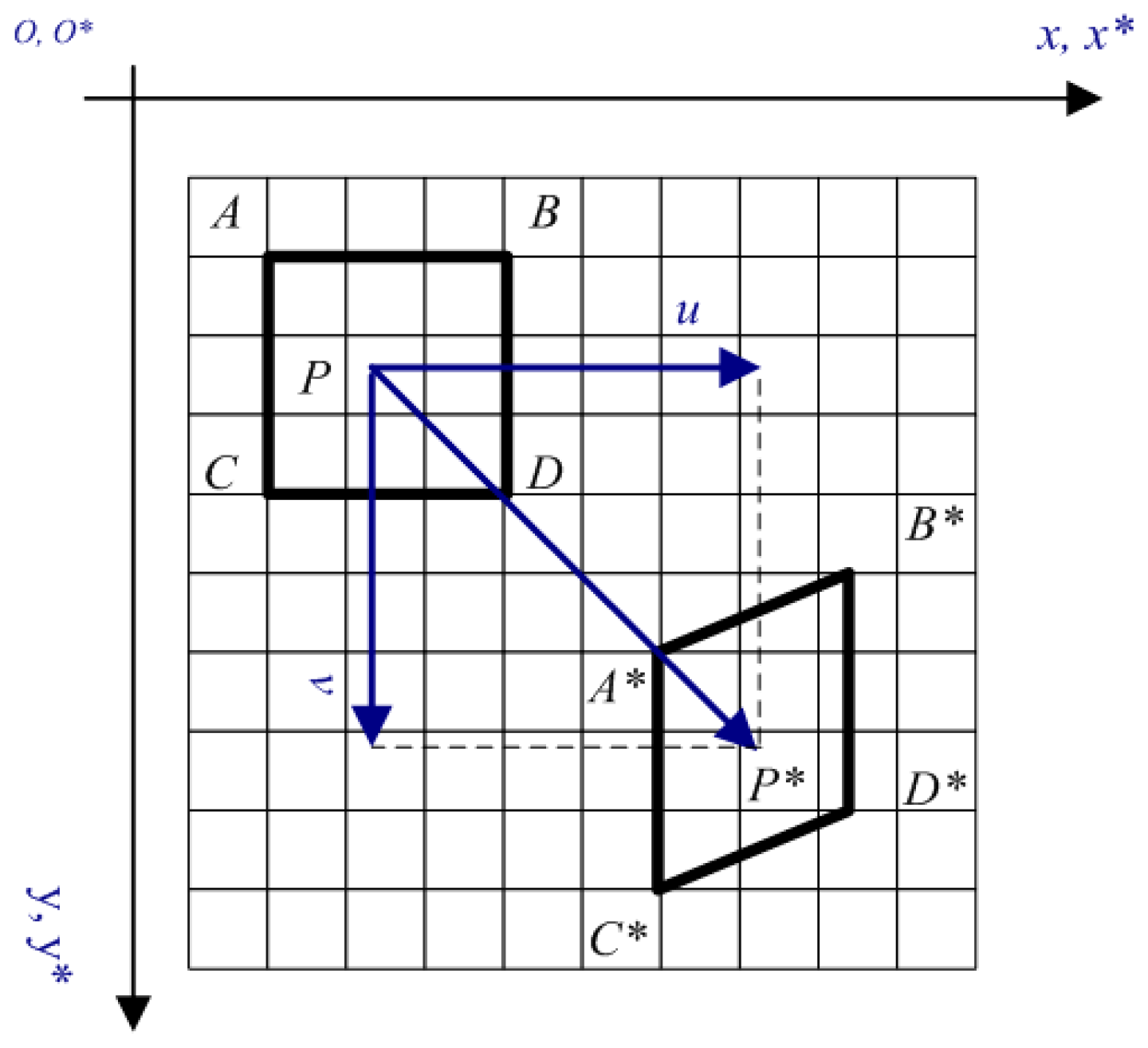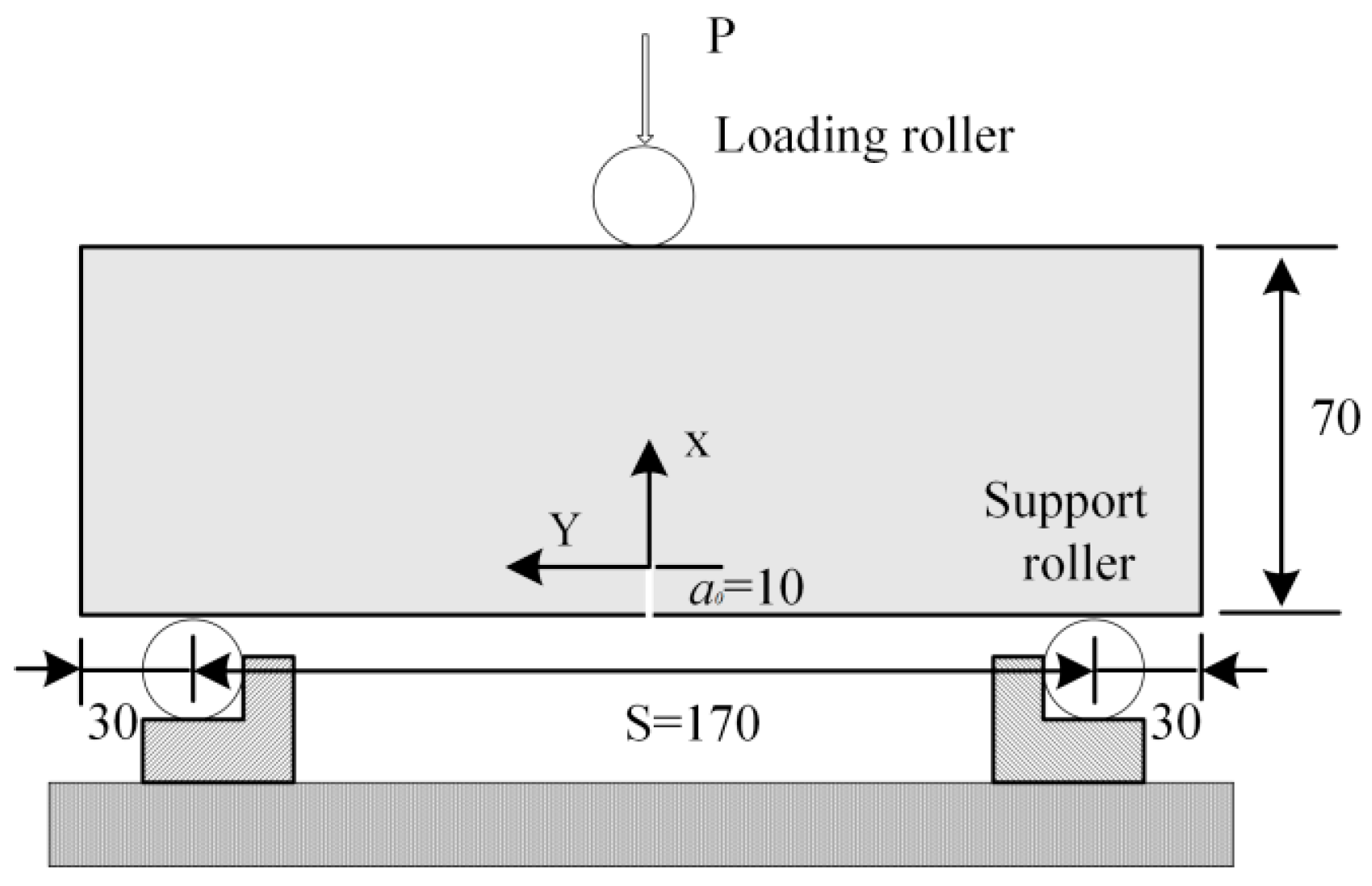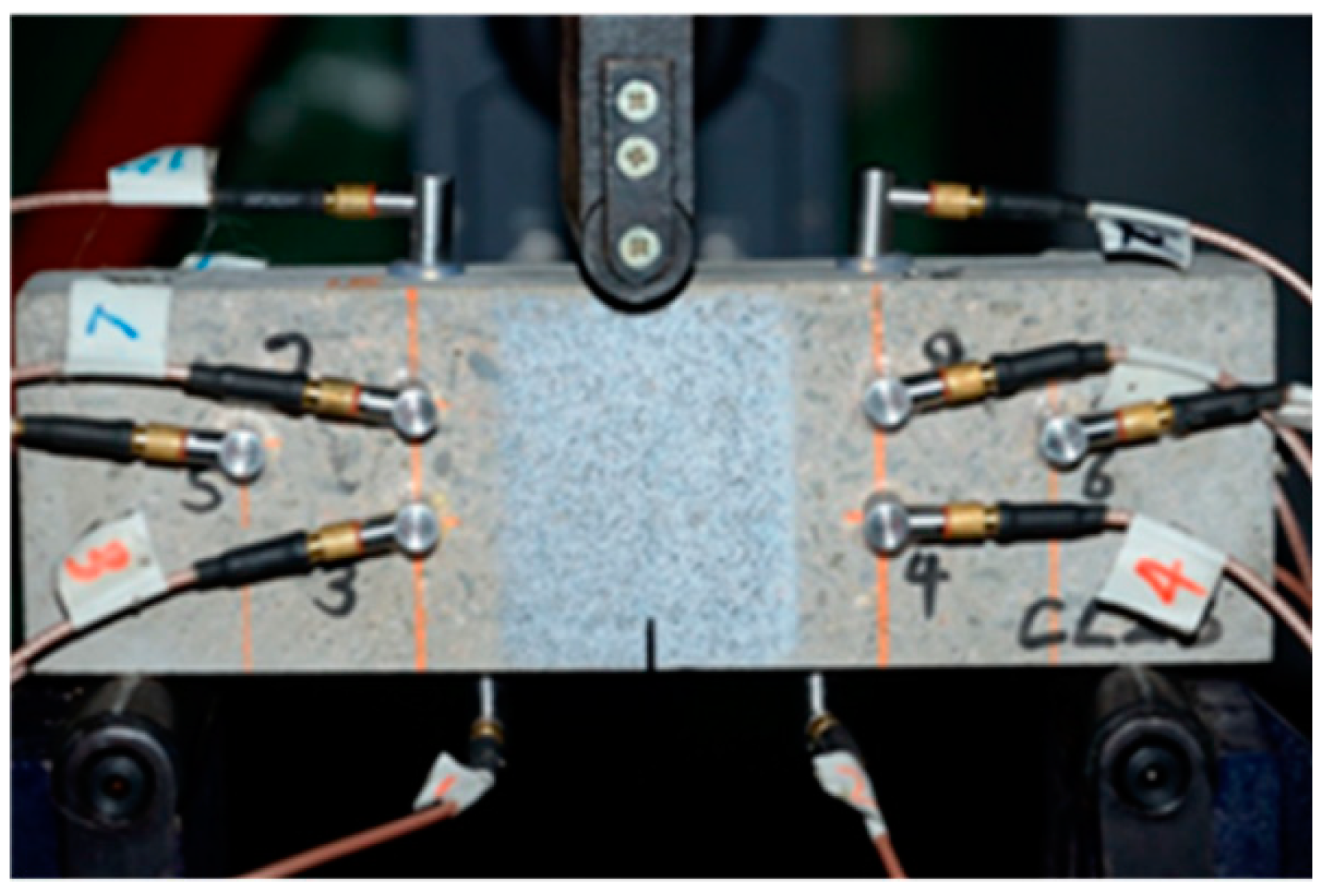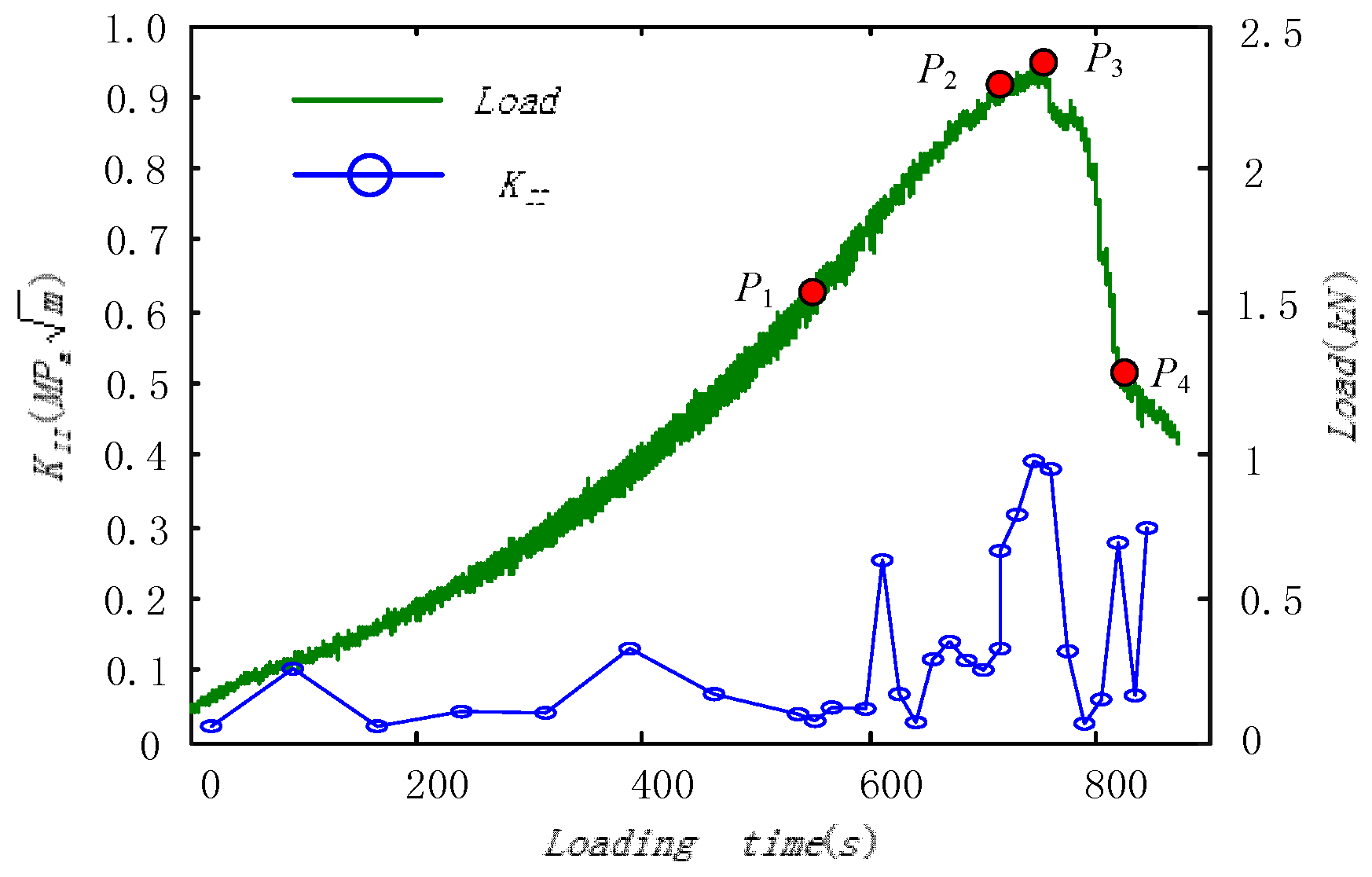Experimental Study on the Fracture Process Zone Characteristics in Concrete Utilizing DIC and AE Methods
Abstract
:1. Introduction
2. Experimental Procedure
2.1. Digital Image Correlation Technique
2.2. Estimation of Stress Intensity Factors
2.3. Acoustic Emission Event Localization Technique
2.4. Specimen, Loading Condition, and Measurement System
3. Results and Discussion
3.1. FPZ Evolution and SIFs
3.2. Internal AE Event of FPZ
3.3. Concrete FPZ Characteristics
4. Conclusions
Author Contributions
Funding
Conflicts of Interest
References
- Denarié, E.; Saouma, V.E. Concrete fracture process zone characterization with fiber optics. J. Eng. Mech. 2001, 127, 494–502. [Google Scholar] [CrossRef]
- Skarżyński, Ł.; Tejchman, J. Experimental investigations of fracture process in concrete by means of X-ray Micro-computed tomography. Strain 2016, 52, 26–45. [Google Scholar] [CrossRef]
- Zhao, J.L.; Bao, T.F.; Amjad, U. Optical fiber sensing of small cracks in isotropic homogeneous materials. Sens. Actuators Phys. 2015, 225, 133–138. [Google Scholar] [CrossRef]
- Hadjab, H.; Chabaat, S.M. Use of scanning electron microscope and the non-local damage model to investigate fracture process zone in notched concrete beams. Exp. Mech. 2007, 47, 473–484. [Google Scholar] [CrossRef]
- Peters, W.; Ranson, W. Digital imaging techniques in experimental stress analysis. Opt. Eng. 1982, 21, 427–431. [Google Scholar] [CrossRef]
- Sutton, M.; Wolters, W. Determination of displacements using an improved digital correlation method. Image Vis. Comput. 1983, 1, 133–139. [Google Scholar] [CrossRef]
- Choi, S.; Shah, S.P. Measurement of deformations on concrete subjected to compression using image correlation. Exp. Mech. 1997, 37, 307–313. [Google Scholar] [CrossRef]
- Corr, D.; Accardi, M. Digital image correlation analysis of interfacial debonding properties and fracture behavior in concrete. Eng. Fract. Mech. 2007, 74, 109–121. [Google Scholar] [CrossRef]
- Wu, Z.; Rong, H. An experimental investigation on the characteristics of FPZ in concrete using digital image correlation technique. Eng. Fract. Mech. 2011, 78, 2978–2990. [Google Scholar] [CrossRef]
- Rouchier, S.; Foray, G. Damage monitoring in fibre reinforced mortar by combined digital image correlation and acoustic emission. Constr. Build. Mater. 2013, 38, 371–380. [Google Scholar] [CrossRef] [Green Version]
- Rusch, H. Physical problems in the testing of concrete. Zement Kalk Gips. 1959, 12, 1–9. [Google Scholar]
- Wells, D. An acoustic apparatus to record emissions from concrete under strain. Nucl. Eng. Des. 1970, 12, 80–88. [Google Scholar] [CrossRef]
- Grosse, C.; Ohtsu, M. Acoustic Emission Testing; Springer Science & Business Media: Berlin/Heidelberg, Germany, 2008; pp. 211–212. [Google Scholar]
- Colombo, S.; Forde, M.C.; Main, I.G.; Shigeishi, M. Predicting the ultimate bending capacity of concrete beams from the “relaxation ratio” analysis of AE signals. Constr. Build. Mater. 2005, 19, 746–754. [Google Scholar] [CrossRef]
- Colombo, I.S.; Main, I.G.; Forde, M.C. Assessing damage of reinforced concrete beam using “b-value” analysis of acoustic emission signals. J. Mater. Civ. Eng. 2003, 15, 280–286. [Google Scholar] [CrossRef]
- Muralidhara, S.; Prasad, B.K.R.; Eskandari, H. Fracture process zone size and true fracture energy of concrete using acoustic emission. Constr. Build. Mater. 2010, 24, 479–486. [Google Scholar] [CrossRef]
- Sagar, R.V.; Prasad, B.R.; Singh, R.K. Laboratory investigations on concrete fracture using acoustic emission techniques. In Acoustic Emission and Related Non-Destructive Evaluation Techniques in the Fracture Mechanics of Concrete; Cambridge/Woodhead Publishing: Cambridge, UK, 2015; pp. 137–159. [Google Scholar]
- Guo, M.; Alam, S.Y.; Bendimerad, A.Z. Fracture process zone characteristics and identification of the micro-fracture phases in recycled concrete. Eng. Fract. Mech. 2017, 181, 101–115. [Google Scholar] [CrossRef]
- Xiangqian, F.; Shaowei, H.; Jun, L. Damage and fracture processes of concrete using acoustic emission parameters. Comput. Concr. 2016, 18, 267–278. [Google Scholar]
- Ohno, K.; Uji, K.; Ueno, A. Fracture process zone in notched concrete beam under three-point bending by acoustic emission. Constr. Build. Mater. 2014, 67, 139–145. [Google Scholar] [CrossRef]
- Verbruggen, S.; Aggelis, D.G.; Tysmans, T. Bending of beams externally reinforced with TRC and CFRP monitored by DIC and AE. Compos. Struct. 2014, 112, 113–121. [Google Scholar] [CrossRef]
- Alam, S.Y.; Saliba, J.; Loukili, A. Study of evolution of fracture process zone in concrete by simultaneous application of digital image correlation and acoustic emission. In Proceedings of the 8th International Conference on Fracture Mechanics of Concrete and Concrete Structures, Toledo, Spain, 10–14 March 2013; pp. 1–9. [Google Scholar]
- Alam, S.Y.; Loukili, A. Detecting crack profile in concrete using digital image correlation and acoustic emission. Eur. Phys. J. Web Conf. 2010, 6, 23003. [Google Scholar] [CrossRef] [Green Version]
- Golaski, L.; Goszczynska, B.; Swit, G. System for the global monitoring and evalu ation of damage processes developing within concrete structures under service loads. Balt. J. Road Bridge Eng. 2012, 7, 237. [Google Scholar] [CrossRef]













| Water/Cement Ratio | Cement (kg/m3) | Sand (kg/m3) | Aggregate (kg/m3) | Water (kg/m3) |
|---|---|---|---|---|
| 0.48 | 446 | 593 | 1102 | 214 |
| Load Time (t) | Load (kN) | KI (MPa·m1/2) | KII (MPa·m1/2) | ∆α (mm) | Load/Max Load (%) |
|---|---|---|---|---|---|
| 577.34 | 1.58 | 0.206 | 0.018 | 4.65 | 67.2 |
| 712.26 | 2.29 | 2.545 | 0.281 | 8.35 | 97.4 |
| 752.35 | 2.35 | 3.332 | 0.390 | 15.02 | 100 |
| 825.92 | 1.24 | 3.0065 | 0.281 | 24.63 | 52.8 |
© 2019 by the authors. Licensee MDPI, Basel, Switzerland. This article is an open access article distributed under the terms and conditions of the Creative Commons Attribution (CC BY) license (http://creativecommons.org/licenses/by/4.0/).
Share and Cite
Dai, S.; Liu, X.; Nawnit, K. Experimental Study on the Fracture Process Zone Characteristics in Concrete Utilizing DIC and AE Methods. Appl. Sci. 2019, 9, 1346. https://doi.org/10.3390/app9071346
Dai S, Liu X, Nawnit K. Experimental Study on the Fracture Process Zone Characteristics in Concrete Utilizing DIC and AE Methods. Applied Sciences. 2019; 9(7):1346. https://doi.org/10.3390/app9071346
Chicago/Turabian StyleDai, Shuhong, Xiaoli Liu, and Kumar Nawnit. 2019. "Experimental Study on the Fracture Process Zone Characteristics in Concrete Utilizing DIC and AE Methods" Applied Sciences 9, no. 7: 1346. https://doi.org/10.3390/app9071346





